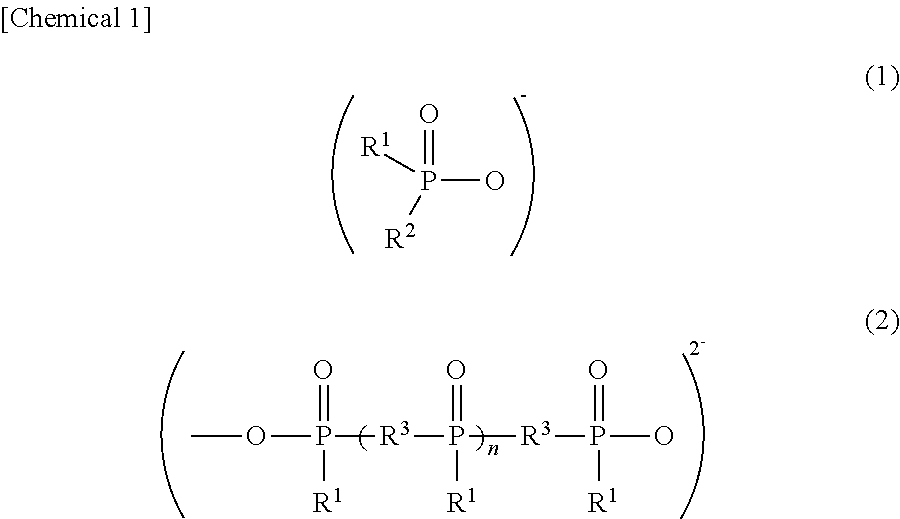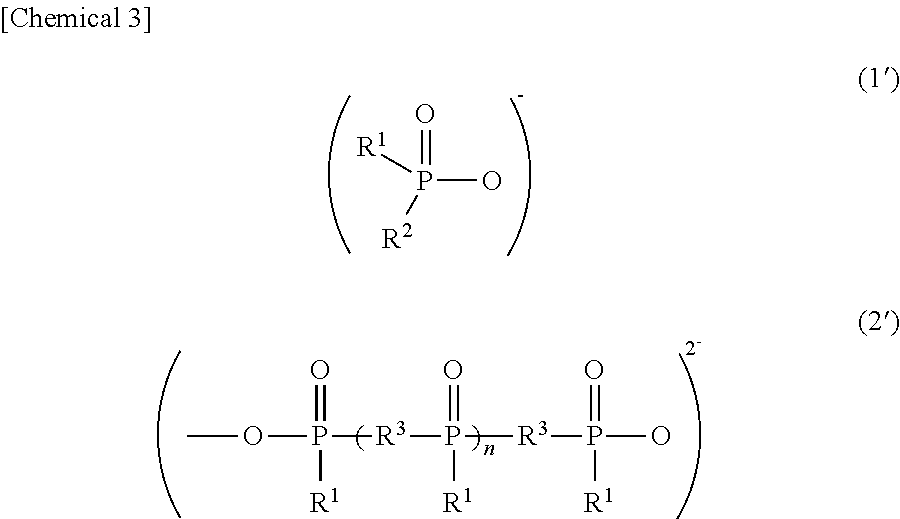Thermoplastic polyester resin composition
a technology of polyester resin and composition, applied in the direction of dyeing process, textiles and paper, etc., can solve the problems of reducing the moldability and mechanical characteristics becoming difficult to use conventional recipes, and affecting the quality of the obtained resin composition, etc., to achieve enhanced flame resistance, enhanced spatial freedom, and large size
- Summary
- Abstract
- Description
- Claims
- Application Information
AI Technical Summary
Benefits of technology
Problems solved by technology
Method used
Image
Examples
example 1
[0215]A burning test specimen having a thickness of 1.6 mm for UL94 (Subject 94, Under-writer's Laboratory) was formed by injection molding, and is subjected to the flexural strength test in the condition that the distance between spans was 40 mm and the testing speed was 2 mm / min.
Weld Flexural Strength
[0216]To the same metal as that used for the above flexural strength testing, the resin was injected from two gates of the both sides in the longitudinal direction of a test specimen to be formed to form a burning test specimen having a thickness of 1.6 mm for UL94 and having weld line formed on the center thereof. Using the obtained specimen, the weld flexural strength test was carried out in the same condition as that in the above flexural strength test. The weld retention was calculated according to the following formula:
(flexural strength of specimen having weld / flexural strength of specimen not having weld)×100%.
[0217]The flame resistance t...
example 1-1 to 1-6
and Comparative Example 1-1 to 1-9
[0248]All the ingredients except for the glass fiber were mixed at the ratio by weight as shown in Table 1 or 2 in the super mixer (manufactured by SHINEI-KIKAI Co., Ltd., SK-350 type), and putting the resulting mixture into the hopper of the double-screw kneader having L / D=42 (manufactured by The Japan Steel Works, Ltd., TEX30HSST), side-feeding the glass fiber to the mixture, and extruding the resulting mixture at the discharge rate of 20 kg / h, the screw revolutions of 250 rpm, and the barrel temperature of 260° C., to thereby obtain pellets of the polybutylene terephthalate resin.
[0249]Using the injection-molder (manufactured by Sumitomo Heavy Industries, Ltd., type: SE50), a burning test specimen having a thickness of 1.6 mm according to UL94, a burning test specimen having weld line (which is used for flexural strength test), a specimen having a thickness of 0.8 mm for UL94, and a Lest specimen for the comparative tracking index test (the lengt...
example 2
Tensile Strength and Tensile Elongation:
[0252]According to ISO527-1, 2, the tensile strength and tensile elongation were measured. When the tensile elongation is larger, toughness is higher.
Weld Tensile Strength:
[0253]To a mold having the same size as the metal for the above ISO tensile testing, the resin was injected from two gates of the both sides in the longitudinal direction of a test specimen to be formed to form a burning test specimen having weld line formed on the center thereof. Using the test specimen, the evaluation was carried out. The weld performance was determined according to the weld retention, and was evaluated as the weld performance (weld adhesiveness) is superior when the value is high. The weld retention is shown as (tensile strength of a test specimen having weld line / tensile strength of a test specimen not having weld line)×100%.
Burning Test:
[0254]It was carried out as the same method in Example 1.
Comparative Tracking Index Test (Abbreviated Expression: CTI ...
PUM
| Property | Measurement | Unit |
|---|---|---|
| melting point | aaaaa | aaaaa |
| specific surface area | aaaaa | aaaaa |
| thickness | aaaaa | aaaaa |
Abstract
Description
Claims
Application Information
 Login to View More
Login to View More - R&D
- Intellectual Property
- Life Sciences
- Materials
- Tech Scout
- Unparalleled Data Quality
- Higher Quality Content
- 60% Fewer Hallucinations
Browse by: Latest US Patents, China's latest patents, Technical Efficacy Thesaurus, Application Domain, Technology Topic, Popular Technical Reports.
© 2025 PatSnap. All rights reserved.Legal|Privacy policy|Modern Slavery Act Transparency Statement|Sitemap|About US| Contact US: help@patsnap.com



